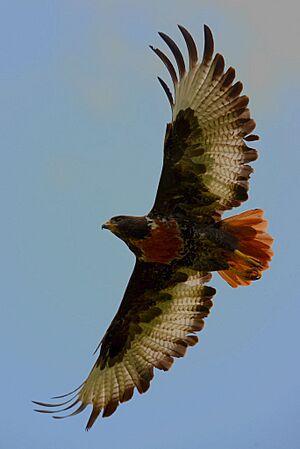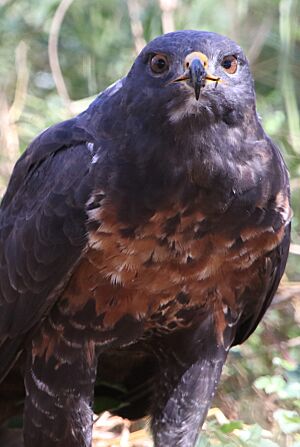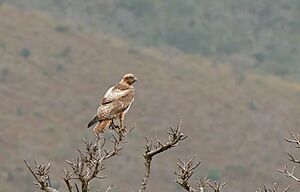Jackal buzzard facts for kids
Quick facts for kids Jackal buzzard |
|
|---|---|
 |
|
| Jackal buzzard flying in Ithala Game Reserve | |
| Conservation status | |
| Scientific classification | |
| Genus: |
Buteo
|
| Species: |
rufofuscus
|
| Subspecies | |
|
3 ssp., see text |
|
The jackal buzzard (Buteo rufofuscus) is a fairly large African bird of prey. It is known for its striking colors and loud call. This bird lives in mountains, grasslands, and savannas. It stays in the same area all year and does not migrate. Scientists have studied this species a lot. They believe it is closely related to other African buzzards. These include the Archer's buzzard and the augur buzzard.
Contents
What Does the Jackal Buzzard Look Like?
The jackal buzzard is one of the two largest Buteo species in Africa. Its close relative is the augur buzzard. Adult birds can be about 44 to 60 centimeters (17 to 24 inches) long. They usually weigh between 790 and 1,700 grams (1.7 to 3.7 pounds). Their wingspan can reach from 127 to 143 centimeters (4.2 to 4.7 feet).
Adult jackal buzzards have very striking feathers. They are almost black on top with a reddish-brown (rufous) tail. Their flight feathers are blackish and off-white. Below, their chin and throat are chestnut colored. The rest of their underside is a rich rufous color. Their belly is black with faint white stripes. When they fly, you can see a large white patch on their underwings. This patch stands out against the black tips and edges of their wings.
Besides its unique colors, the jackal buzzard has a short tail and broad wings. It has a bulky body and a large beak. Young jackal buzzards look different. They are mostly brown on top. Their underside is a faded reddish-buff brown. Their tail is usually buff-brown.
The Jackal Buzzard's Call
The jackal buzzard makes a sharp, barking sound. It sounds like weeah ka-ka-ka or kyaahh-ka-ka-ka. The female's voice is deeper than the male's. This call sounds a bit like a black-backed jackal. This is how the bird got its common name. Its call is also different from other buzzards in the area.
Where Do Jackal Buzzards Live?
The jackal buzzard lives only in southern Africa. Even though its home range is limited, it is a common bird of prey. It lives in most of South Africa. Its range also extends into central Namibia, Lesotho, and Eswatini. It can also be found in southern Mozambique and southeast Botswana.
This bird mostly lives in mountains. However, it can also be found in rocky areas near the sea. It lives in high mountains in Lesotho up to 3,500 meters (11,500 feet) high. It can live in dry, desert-like places. It also lives in areas with lots of rain and green plants. It prefers to be near grasslands for hunting.
Protecting Jackal Buzzards
Jackal buzzards are common and can adapt to many places. But they can still be in danger from human-made things. These include wind turbines, power lines, and large reservoirs. They can also be harmed by poisoned meat. This poison is often meant for animals like jackals.
Reproduction and Life Cycle

Jackal buzzard pairs make loud sounds and fly together. They do this even when it's not breeding season. Their flight displays are not as dramatic as some other buzzards. They usually just circle or gently dive. The main breeding season is from July to December. However, it can start as early as May or end as late as March.
The birds build a large nest out of sticks. They build it in a tree or on a cliff. They often use the same nest year after year, making it bigger each time. A new nest is about 60 to 70 centimeters (24 to 28 inches) wide. It is about 35 centimeters (14 inches) deep. But old nests can be more than 1 meter (3.3 feet) wide.
The female lays two (or very rarely three) creamy or bluish-white eggs. She lays them about three days apart. Only the female sits on the eggs to keep them warm. The male brings her food to the nest. The eggs hatch in about 40 days. The young birds can try to fly after another 56 to 60 days. The parents will attack anyone who comes too close to the nest. Sometimes, if there isn't enough food, only one chick will survive. Young birds become independent around 70 days old. But they might stay with their parents for a while after that.
What Do Jackal Buzzards Eat?
The jackal buzzard mainly eats small animals that live on the ground. These are often rodents like rats and grass mice. They also eat snakes, lizards, and ground-feeding birds. Sometimes they eat baby birds from other nests. They also eat insects and animals killed on roads.
This bird usually hunts by waiting on a perch. This could be a tree or a pole. Then it drops down onto its prey. It catches its prey mostly on open ground, including roads. It can also hunt by soaring high in the sky. Sometimes it hovers or hangs in the air using wind currents.
Hunting and Scavenging
A study in Grahamstown, South Africa, found that buzzards mainly ate small mammals when nesting. After nesting, they often eat dead animals (carrion). They have been seen eating dead sheep and goats. They also eat animals killed on roads, like hares and springboks.
Many other scavengers live in their area. These include vultures, jackals, and hyenas. These animals are larger and often aggressive. So, the jackal buzzard usually only eats carrion after other scavengers are finished. Or it eats when no other scavengers are around. Jackal buzzards are less shy around humans than larger birds of prey. This might help them get to road-killed animals faster. They might also get an advantage by eating from large carcasses that bigger scavengers have already opened up.
Jackal buzzards have also been recorded taking larger or more dangerous live prey. This includes adult francolins and marsh owls. They also hunt adult puff adders and greater cane rats. They mostly eat the young of various mongoose, monitor lizards, and Cape hyraxes.




